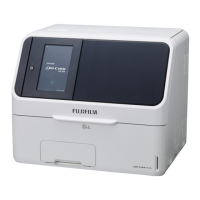
Do you have a question about the FujiFilm FUJI DRI-CHEM NX700 and is the answer not in the manual?
| Model | FUJI DRI-CHEM NX700 |
|---|---|
| Manufacturer | FujiFilm |
| Power Supply | AC 100-240 V, 50/60 Hz |
| Type | Clinical Chemistry Analyzer |
| Measurement Method | Reflectance Photometry |
| Sample Type | Serum, Plasma, Urine, Whole Blood |
| Sample Volume | 10-30 µL |
| Throughput | Up to 120 tests per hour |
| Photometric System | Reflectance photometry |
| Data Storage | 10, 000 samples |
| Display | Color LCD touch screen |
| Operating Environment | Temperature: 15-30°C, Humidity: 20-80% RH |
Explains symbols and their meanings for safety warnings.
Details essential safety rules for operating the analyzer correctly.
Covers safe handling and disposal procedures for biological waste.
Warns against using flammable gases near the equipment.
Provides critical precautions to prevent electrical shock hazards.
Warns users to keep clear of mechanical moving parts during operation.
Specifies environmental conditions and site requirements for safe installation.
Outlines immediate steps to take if the analyzer malfunctions.
Explains the function and use of QC cards for measurement accuracy.
Details safe procedures for handling biological samples.
Identifies and illustrates all external and internal parts of the analyzer.
Explains the interface and interactive elements of the touch panel screen.
Details the primary screen for initiating and preparing measurements.
Describes the on-screen keyboard used for data input and configuration.
Lists all accessories and components included with the analyzer package.
Lists all necessary consumables and available optional items for the analyzer.
Provides a high-level summary of the measurement process steps.
Outlines the necessary steps before starting any measurement sequence.
Explains the procedure for powering on and initiating the analyzer.
Guides users through the fundamental steps of performing standard measurements.
Describes how to view and interpret the results displayed after a measurement.
Provides specific instructions for performing Ion-Selective Electrode (ISE) tests.
Details the process for performing measurements that require sample dilution.
Explains the correct procedure for powering off the analyzer.
Describes how to use QC cards to ensure accurate and consistent measurements.
Explains how to calibrate the analyzer for CRP measurements.
Describes how to pause, cancel, or prioritize sample applications.
Provides instructions for applying samples manually to slides.
Explains how to perform tests using the plasma filter unit.
Guides on how to re-run a measurement for a previously tested sample.
Explains how to import sample data automatically from a host system.
Details how to modify sample identification information after measurement.
Explains how to use an optional barcode reader for sample and operator ID entry.
Provides an overview of the process for loading all types of consumables.
Details the procedure for loading new pipette tips into the analyzer.
Explains how to load the necessary mixing cups for specific test types.
Guides users on how to load the diluent into the appropriate container.
Details the procedure for loading the reference fluid for ISE measurements.
Outlines the schedule and types of maintenance tasks required for the analyzer.
Provides instructions for cleaning the analyzer's air filters to maintain performance.
Details procedures for inspecting and cleaning critical internal components.
Guides on how to safely replace and clean the analyzer's light source lamp.
Details the process for inspecting and replacing the sampler O-ring for accurate sample application.
Details maintenance procedures specific to the PF (plasma filter) unit.
Advises on the selection and use of appropriate control fluids for QC.
Provides steps to resolve issues when control results are inconsistent.
Details how to view and interpret control charts for quality monitoring.
Explains how error messages are displayed and what they signify.
Provides a comprehensive list of error codes and their corresponding troubleshooting sections.
Addresses issues encountered when starting up the analyzer.
Details troubleshooting steps for errors related to reading slide information.
Lists common errors related to the sampler unit's operation.
Addresses issues concerning the analyzer's photometric system.
Covers errors related to the movement and transfer of slides and samples.
Explains errors related to temperature control within the analyzer.
Covers troubleshooting for incorrect sample or slide loading procedures.
Addresses specific errors encountered during ISE (Ion-Selective Electrode) measurements.
Details troubleshooting steps for errors related to the PF (plasma filter) unit.
Covers troubleshooting for communication and barcode reader issues.
Addresses errors that may occur during the calibration process.
Explains how to use the Control mode for measurement of control serum and surveys.
Details functions accessible by general operators, like time and brightness settings.
Guides on how to set the analyzer's internal date and time.
Explains how to adjust LCD brightness and buzzer volumes.
Covers monitoring lamp usage time and auto-off settings.
Describes how to view and print information about registered QC card lots.
Outlines advanced settings and configurations accessible by administrators.
Allows selection and configuration of the user interface language.
Details how to configure communication settings for connecting to a host computer.
Explains how to configure parameters for calculating results from multiple measurements.
Guides on setting primary and secondary units for measurement items.
Covers setting and managing reference intervals for sample information.
Allows entry, reset, and printing of correlation coefficients for sample types.
Covers inputting lot-specific compensation coefficients from QC cards.
Details how to enter calibration curve coefficients manually.
Allows setting dilution factors and diluent positions for measurement items.
Configures control liquid names, lot numbers, and acceptable ranges.
Controls the display of Operator ID on measurement screens.
Explains how to transmit measurement results to external computers.
Details the process of inputting an Operator ID for system access.
Explains how operator roles restrict access to different analyzer functions.
Provides access to User Safety Mode functions for managing operator IDs.
Guides on importing operator ID data from a USB drive.
Explains how to export operator ID data to a USB drive.
Details how to modify existing operator IDs, including expiry and level.
Covers setting and editing emergency IDs and their associated measurement limits.
